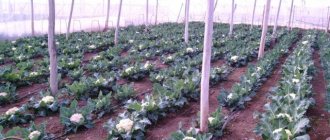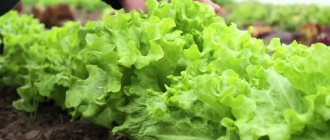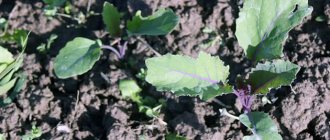All varieties of cabbage
The most popular type of cabbage is white cabbage. It is easy to care for, has a high content of vitamin C and does not provoke allergies.
But there are other varieties that grow and develop safely both in open ground and in greenhouse conditions.
Peking cabbage variety
This vegetable belongs to the early ripening species. It completely “sets” 1.5-2 months after germination. This can be determined by the dense head of cabbage. The weight of a mature vegetable reaches 300 grams. This variety does not require special care, but loves abundant watering.
- The main condition for growth is temperature conditions. For seedlings to emerge, the temperature must be at least 20 degrees, and seedlings develop rapidly at 22 degrees daytime and 16 degrees night temperature.
- For growing in a greenhouse, the optimal temperature is 16-18 degrees. Air humidity in the greenhouse should not exceed 80%. Humus is suitable as a fertilizer for Chinese cabbage.
If you follow these simple rules of care, you can get a generous harvest of Chinese cabbage.
Cauliflower variety
It is advisable to grow this species in a greenhouse, as it is quite demanding in terms of conditions for its growth and development. The plant needs to create high air humidity, but do not forget to periodically ventilate the room.
This condition must be observed in order for the cabbage to form a tight head. The required temperature conditions are not higher than 18 degrees.
It is not recommended to apply nitrogen fertilizers. This vegetable already has a good vegetative process.
Otherwise, the inflorescences will begin to stretch out, and getting a strong head of cabbage will be problematic. It is optimal to use boric acid as a top dressing.
Broccoli variety
This cabbage is especially popular among consumers. Contains essential substances such as choline and methionine. These substances reduce the level of “bad” cholesterol in the blood, which serves as a prevention of cardiovascular diseases.
In addition, broccoli has a diverse set of vitamins and microelements. Therefore, nutritionists from all countries recommend including this cabbage in your diet.
- Broccoli is an unpretentious cultivated plant. In greenhouse conditions it germinates quite quickly from seeds.
- Literally 1.5 weeks after sowing it may have 2-3 leaves.
- Cabbage needs good soil, so in the fall it should be dug up and organic and ammonia fertilizers applied.
To increase the yield, you must remember to trim the cabbage on time. Temperature is also important: daytime temperature is 18°C, night temperature is 12°C.
Kinds
White cabbage
When to sow cabbage for seedlings
The most common type. It is from this that cabbage soup and cabbage rolls are prepared. The heads of cabbage are light emerald in color. This species is grown almost everywhere except the Far North. White cabbage grows well even in cold summers; slight frosts do not harm it. The material will discuss growing cabbage for seedlings in a greenhouse.
Note! Cabbage is rich in vitamins C, P, A, group B, etc. It helps heal festering wounds, treats problems with the gastrointestinal tract, and relieves depression. For those who want to lose weight, cabbage is an indispensable product in the diet. Its calorie content is only 27 kcal.
Known varieties:
- Amager;
- Kolobok;
- Merchant's wife;
- Mara;
- Sugar Queen;
- June, etc.
Red cabbage
This species resembles white cabbage. The difference is in the color of the leaf plates. In the red cabbage they are purple. Despite the fact that this type is not so popular, it is superior in taste to white cabbage due to its tenderness and richness.
Known varieties:
- Primero F1;
- Gako 741;
- Mars, etc.
Red cabbage
Colored
The edible part of this vegetable is dense, fused inflorescences. Depending on the variety, the color can be white-cream, snow-white, lilac, or green.
Popular varieties:
- Snowball;
- Flora Blanca;
- Cortez F1;
- Alpha, etc.
Broccoli
Small heads, similar to inflorescences, are eaten. Their color is dark emerald. This product does not cause allergies. Broccoli puree is used as complementary food for babies.
Broccoli
Popular varieties:
- Vitamin;
- Linda;
- Arcadia F1;
- Continental.
In addition to these types, there are Brussels sprouts, kale, savoy, kohlrabi, etc.
Features of growing cabbage in a greenhouse
Any type and variety of cabbage, as a rule, fully ripens by the end of August. But by growing vegetables in a greenhouse, you can get the harvest much earlier, around June-July. The greenhouse is good for growing vegetables in it, which allows you to regulate the light, temperature and heating of the room.
Cabbage can be grown as seedlings directly in the ground, or you can first sow the seeds in boxes and then transplant them into the ground. In greenhouse conditions, seedlings grow and develop quickly.
Cultural information
Cabbage is a vegetable that belongs to the Cruciferous family. The culture has been known since ancient times. The plant is biennial. In the first year it forms a large, strong head of cabbage. The head is actually a bud located at the top of the stem. The stem is powerful and durable. Its diameter is about 3-7 cm. It is used as food. The head of cabbage consists of upper and lower leaves. The leaf blades are elastic and large. Depending on the variety, the head (another name for the head of cabbage) can be from 1 to 8.5 kg.
In the second year, the plant grows a long, thin stem. It is abundantly strewn with branches. The branches bear yellow or cream flowers. Cabbage fruits grow in the form of pods containing seeds.
Cabbage
The best varieties of cabbage for growing in a greenhouse
Experienced gardeners and gardeners recommend growing early varieties of cabbage in greenhouses, explaining that they are excellent for fresh consumption in salads and for preparations.
Early varieties include:
"Ditmar's Early"
It is considered the earliest ripening cabbage of the early varieties. When seedlings are planted in a greenhouse, they fully ripen in 50-70 days. It has a characteristic appearance: a tight head of soft green color, round, but slightly flattened. It is juicy, crunchy and has a pleasant sweetish taste.
"Golden hectare 1432"
The heads of cabbage grow quite large, weighing up to 3 kg. Full ripening occurs within 130 days after emergence. Cabbage is white and does not crack when ripe. It has a pleasant taste, so it is suitable for preparing salads and preparations for the winter.
"Number one K-206"
Gives a good yield of up to 40 kg per 10 square meters. m. Heads of cabbage are medium, weighing up to 2 kg. It takes up to 120 days to fully ripen. It is valued by gardeners for its excellent seed germination and excellent taste.
Cabbage scoop
Gives 1÷2 generations.
Caterpillars are up to 5 cm long, almost cylindrical, thick, naked, very variable in color - from grayish-green to almost black. The larvae first scrape out the leaf tissue from the underside, then spread out and gnaw out irregularly shaped holes in the leaves. They feed at night and hide at the base of the head of cabbage during the day. Older caterpillars eat up the leaves almost completely and also penetrate into the heads of cabbage, making passages in them and polluting them with excrement, as a result of which the heads of cabbage rot and acquire an unpleasant odor.
Planting cabbage in a greenhouse (step-by-step instructions)
Growing cabbage in a greenhouse is not difficult. Even an inexperienced vegetable grower can cope with this task. The main thing is to comply with the conditions and know what time is best to plant cabbage. The most optimal period for planting seedlings is mid-April.
To get good seedlings, it is important to sow the seeds correctly. First you need to select them. As a rule, large seeds that are dark in color and large in size can be considered suitable for germination.
Before sowing, they need to be prepared by soaking. You should immerse the seeds in hot water (50°C) for 20-25 minutes, then pour cold water over them for a couple of minutes and dry on a paper towel.
Next, the seeds are sown in a greenhouse. To do this you need:
- Dig a trench (depth 30 cm, width 100 cm);
- Place biofuel on the bottom (old things, paper, humus of leaves and grass);
- Sprinkle soil on top.
For seedlings, the best option would be a substrate consisting of equal parts:
- Sod land;
- Peat;
- Sand.
Prevention of pests and diseases
As soon as the first tiny leaves grow from the ground, they are treated with a solution of water and acetic acid. A few tablespoons of acid are dissolved in a 10-liter bucket of water. You should get a weak solution. This treatment will protect the crop from pests. It is possible to treat seedlings with an insecticide instead of vinegar. You can take Thiamethoxam or Diazinon.
It is important to observe crop rotation. Cabbage cannot be planted after other cruciferous vegetables, since they have the same diseases and pests. Before planting, the soil can be treated with drugs against pests living in the soil. Available: Grom, Zemlin.
In order to prevent insect invasion, fragrant flowers and herbs (marigolds, calendula) are planted next to the cabbage.
Treatment with Fundazol before planting seeds will help prevent diseases. Also, before planting, the soil is disinfected with a manganese solution.
To grow healthy cabbage seedlings in a greenhouse, both proper planting and proper care are important. In addition, the gardener should take care of the prevention of diseases and pests that can overcome the crop.
0 0 votes
Article rating
Caring for cabbage seedlings
The seeds are planted in soil heated to 20°C to a depth of 1 cm. Next, it is important to create a greenhouse effect by installing a frame with film. When the first shoots appear, and this is already approximately on the 4th day, the greenhouse can be opened for a short time, but in the daytime.
This is done to harden the seedlings and smoothly adapt to new atmospheric conditions. Watering at this stage is not recommended.
The optimal temperature is 10-12 degrees. But after the first two leaves appear, you can add watering and fertilizing with a phosphorus-potassium mixture.
FAQ
Is it possible to do without picking?
You can do without picking, initially plant each seed in a separate pot
What to choose for cabbage: purchased soil or a mixture of regular soil and humus?
Since store soil contains the optimal amount of minerals and organic matter, it is best to use it.
Is it possible to do without fertilizing the container with seedlings?
Yes, but in this case you should thoroughly fertilize the soil before planting the seedlings in the garden.
Is it possible to store seedlings on a windowsill?
The battery under the windowsill heats up the container greatly, which leads to a decrease in the germination percentage, so it is best to use a special rack.
Do I need to add light to the seedlings?
Depends on the timing of planting - cabbage should have at least 10 hours of daylight.
Cabbage care
Caring for cabbage in a greenhouse does not present any particular difficulties. All she needs is:
- Regular watering.
- Fertilizing with organic fertilizer.
- Daylight hours are 14-17 hours.
- Temperature range is 16-20°C.
- Air humidity 70-80%.
- Regular watering.
In greenhouse conditions, early varieties of cabbage grow and develop safely. If you create all the necessary conditions, you can get a rich harvest of cabbage, prepare fresh salads from it, or store it for the winter.
Diseases and pests
The disadvantage of growing seedlings in a greenhouse is that young bushes can be attacked by harmful insects. Among the most common:
- Cruciferous flea beetle. Pest control involves treating plants with fly ash or tobacco dust.
- Cabbage fly. Treatment with Karbofos will get rid of cabbage flies.
- Aphid. Ash, vinegar or soap solutions will help against aphids.
Aphid
In addition, seedlings can develop the following diseases:
- Black leg. This disease has no cure. The diseased seedling is removed. The soil is treated with potassium permanganate.
- Perenosporosis. To destroy the pathogen, Planriz and Thiram are used.
Photo of growing cabbage in a greenhouse
Harvest
Ripe heads of cabbage are cut with 4 leaves and a small piece of stem. Unripe ones can be brought to the required condition using a simple scheme:
- the bush is dug up by the roots;
- transferred to the cellar;
- A thin layer of soil is poured on top of the plant.
With proper watering, the cabbage will ripen and increase its weight by 300–500 g. The same result is achieved by hanging the cut bushes with their roots up.
Cabbage is stored in cellars for 110–120 days. In the refrigerator, it does not lose its taste characteristics and does not deteriorate for 50 days.
If you divide the forks into inflorescences, pour water over them, dry them, remove all rotten fragments, place it in a bag and put it in the freezer of the refrigerator, it will easily overwinter. And you can please yourself with fresh vegetables without waiting for a new harvest.











